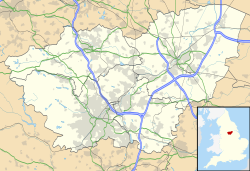| Conisbrough Castle | |
|---|---|
| Castle Hill, Conisbrough, Doncaster, England | |
 The castle seen from the south-east | |
| Coordinates | 53°29′03″N 1°13′35″W / 53.48417°N 1.22639°W |
| Type | Castle |
| Height | 62 feet (19 m) |
| Site information | |
| Owner | Doncaster Metropolitan Borough Council and English Heritage |
| Open to the public | Yes |
| Condition | Ruined |
Listed Building – Grade I | |
| Official name | Conisbrough Castle |
| Designated | 26 November 1987 |
| Reference no. | 1192747 |
| Site history | |
| Built | 11th century |
| Materials | Magnesian Limestone |
Conisbrough Castle is a medieval fortification in Conisbrough, South Yorkshire, England. The castle was initially built in the 11th century by William de Warenne, the Earl of Surrey, after the Norman conquest of England in 1066. Hamelin Plantagenet, the illegitimate, parvenu brother of Henry II, acquired the property by marriage in the late 12th century. Hamelin and his son William rebuilt the castle in stone, including its prominent 28-metre (92 ft)-high keep. The castle remained in the family line into the 14th century, despite being seized several times by the Crown. The fortification was then given to Edmund of Langley, passing back into royal ownership in 1461.
Conisbrough Castle fell into ruin, its outer wall badly affected by subsidence, and was given to the Carey family in the 16th century. Its derelict state prevented it from involvement in the English Civil War of the 17th century and the remains were bought by the Duke of Leeds in 1737. Sir Walter Scott used the location for his 1819 novel Ivanhoe and by the end of the 19th century the ruins had become a tourist attraction.
The state took over the management of the property in 1950, but by the 1980s the visitor facilities were felt to be unsuitable, leading to a three-way partnership being created between the local council, the state agency English Heritage and a local charitable trust to develop the castle. The keep was re-roofed and re-floored in the 1990s with the help of European Union funding. English Heritage took over control of the castle in 2008 and continues to operate the property as a tourist attraction.
The castle is made up of an inner and an outer bailey, the former surrounded by a stone curtain wall defended by six mural or fortified towers and the castle keep. The inner bailey would have included a hall, solar, chapel and other service buildings of which only the foundations survive. The design of Conisbrough's keep is unique in England, and the historians Oliver Creighton and Stephen Johnson consider it an "architectural gem" and "one of the finest examples of late Norman defensive architecture". The keep comprises a circular central tower with six massive buttresses; its four floors would have included a main chamber and a private chamber for the lord above it. Although militarily weak, the design would have been a powerful symbol of Hamelin Plantagenet's new social status as a major lord.
